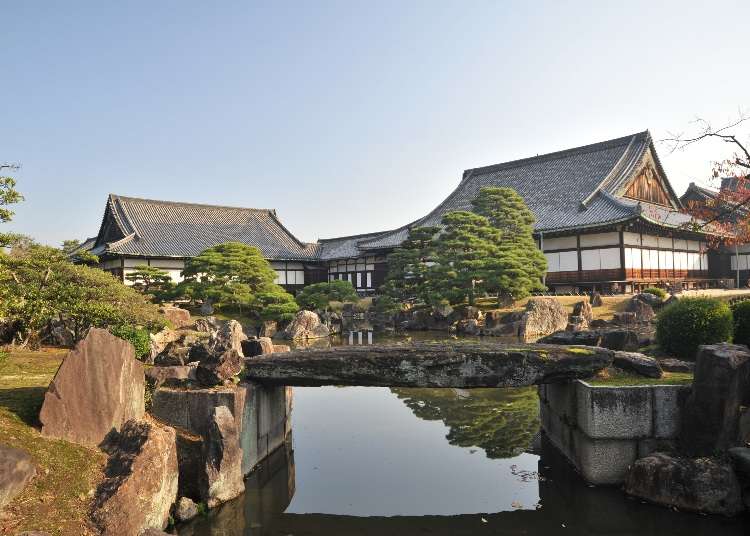
Nijo Castle is one of Kyoto’s world-famous UNESCO World Heritage sites, constructed in 1603 by Ieyasu Tokugawa - the first shogun of the Edo Period.
During the age of the third shogun, Iemitsu Tokugawa, Nijo Castle underwent significant renovations to accommodate Emperor Go-Mizunoo. This is when murals drawn by Kano Tanyu were commissioned, among other artworks. Today, the well-preserved buildings of Nijo Castle and Ninomaru Palace are masterpieces that draw visitors from around the world.
Let’s take a look at the history of Kyoto's Nijo Castle, enjoying the glamorous outfits and beautifully kept gardens!
- Table of Contents
-
- Getting to Nijo Castle and best time to visit
- You have to check out the Kano school murals in the Ninomaru Palace!
- Ninomaru Garden, an original part of Nijo Castle
- Beautiful green grass and a paved path: Honmaru Garden
- A view of Kyoto from the tenshu remains
- Seiryu-en Garden: A blend of east and west in gardening
- Enjoy a matcha café after your castle trek at Sanoah
- What do you need to look out for when visiting Nijo Castle Kyoto?
Getting to Nijo Castle and best time to visit
How to get to Nijo Castle
Nijo Castle is a short walk from Nijojo-mae Station on the Kyoto Subway Tozai Line. From Kyoto Station, take the Subway Karasuma Line to Karasuma-Oike Station, then transfer to the Tozai Line to Nijojo-mae Station. The trip takes around 15 minutes and costs 260 yen.
How much does it cost to go to Nijo Castle?
Admission is 620 yen for adults, and an additional 410 yen is charged for admission to the Ninomaru Palace.
Self-guided audio tours in English, Chinese, Korean, French, Spanish, and German are available at a kiosk inside the main gate and cost 520 yen to rent.
Nijo-jo Castle offers guided tours in English conducted every day the grounds are open. (Note: As of 2021, these tours are currently suspended due to Covid-19.)
When is the best time to visit Nijo Castle?
Spring is a particularly beautiful time to visit during the Nijo Castle Sakura Festival (late March to mid-April).
You have to check out the Kano school murals in the Ninomaru Palace!

After entering Nijo Castle through the large east gate and stepping through another grand one to get to Ninomaru Palace, you’ll find that it’s a valuable site as an example of early Edo period residential architecture. Its uniqueness has earned it the privilege of being the only palace within a castle to be designated as a natural treasure.
Inside, you’ll find the Tora no Ma, a room for guests to wait in, the Shikidai, the place where the news would be announced to the shogun, and the Ohiroma, where the last scene of the Edo period played out.
Past the Orhioma, you can find the public Kuro-shoin (where the Shogun would meet with high-ranking officials), as well as the shogun’s private Shiro-shoin (private quarters for the Shogun).
If there’s something you have to see in Ninomaru Palace, it would be the murals by Karino Tanyu’s school. Foremost is the painting of a hawk on pine branches, as well as beautiful paintings of tigers, leopards, cherry blossoms, and other seasonal flowers.
The gold-decorated wall virtually glowed before all who saw it, displaying the shogun’s authority. The partitions between the rooms and on their upper parts have lavishly made sculptures and decorations, giving the interior a glamor befitting of the shogun’s quarters.
The nightingale corridors that make the sound of a bird’s chirp when walked through are also of note.
Ninomaru Garden, an original part of Nijo Castle
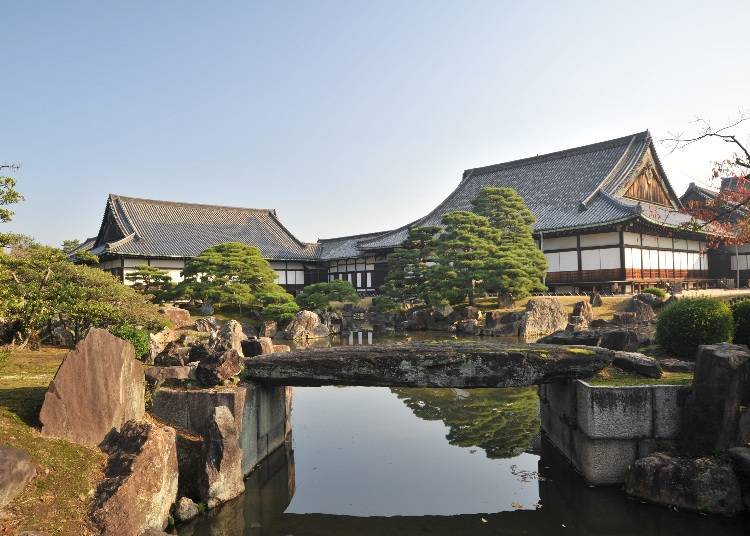
The Ninomaru Garden was constructed for Emperor Go-Mizunoo under the orders of Enshu Kobori in 1626. The garden has a large bond with three islands, in the style of Shoin gardens of the time.
It was made to be viewed from three directions: Ninomaru Palace's great hall, the Kyokushin, and the emperor's quarters. Eventually, the emperor's quarters were moved from Ninomaru Palace as time went on, and the garden changed and was abandoned at the end of the shogunate.
However, when Nijo Castle became the emperor's villa in 1884, the garden underwent large-scale renovations, ending in its current shape. The well-placed rocks and 150-year-old sago palms are worth seeing.
Beautiful green grass and a paved path: Honmaru Garden
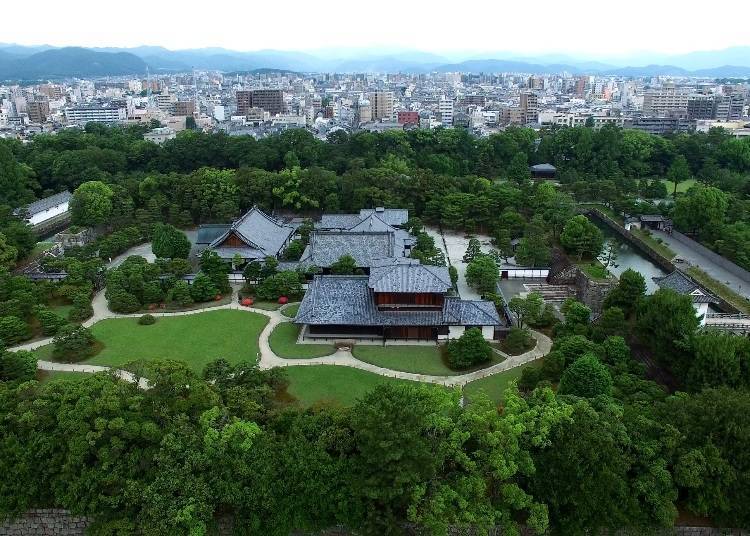
Leaving the Ninomaru Garden, you'll find the Honmaru area, surrounded by the inner moat. Within the Honmaru's 20,000 square meter area, you'll find the Honmaru Palace, a reconstructed version of the Katsuranomiya Palace moved from Kyoto Palace in 1893, and the Honmaru Garden, which was renovated to accommodate the Meiji Emperor.
General visitors aren't allowed inside the Honmaru Palace, but you can pass through the Honmaru Garden. The garden has been made with artificial hills, grass, and a curved path to resemble a western garden. The hills have azaleas planted on them, allowing viewers to enjoy their flowers from the end of spring to the beginning of summer.
A view of Kyoto from the tenshu remains
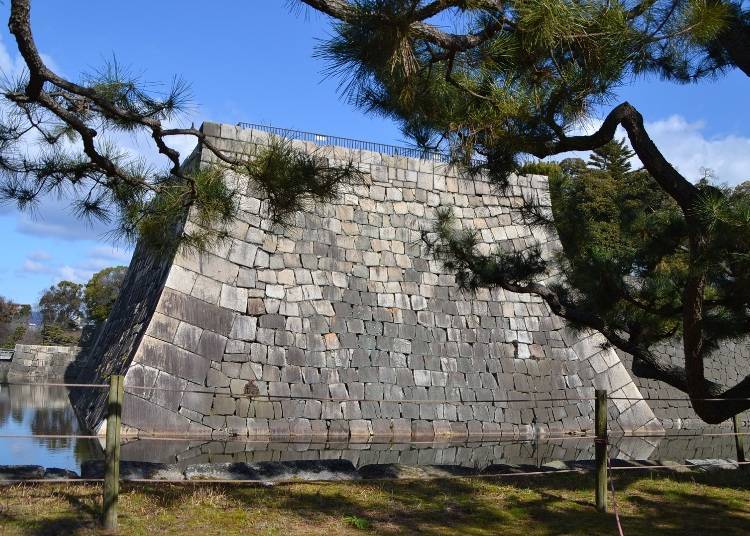
In the southwest corner of the Honmaru, you'll find stone steps that lead to Nijo Castle's tenshu (main castle tower) remains. Initially, Nijo Castle had a five-storied tenshu, but the tower was moved to Yodo Castle during the Edo period renovations. The tenshu remains seen here originally belonged to Fushimi Castle. in 1750, it was struck by lightning and burned down, leaving only the walls remaining.
You can view the Honmaru Palace and Honmaru Garden from these remains, as well as parts of Kyoto, Mount Hiei, and Mount Atago. The spot has a far-reaching view during clear days in winter, giving it popularity.
Seiryu-en Garden: A blend of east and west in gardening

On the north side, you'll find a garden, Seiryu-en. This is where the tenshu tower was said to be when Nijo Castle was first built. When the castle was renovated, and the tenshu tower was moved, a residence for shogunate officials was built to replace it, but this was demolished halfway through the Meiji era and replaced with a garden.
The current Seiryu-en was established in 1965, inheriting parts of Ryoi Sumino's residence, rocks, and trees. The west side is a Japanese-style garden with a trail around the pond, while the east side is a western-style garden with a grass lawn. There's a rock that looks like a lion at the border of the two gardens, so do try to find it.
Enjoy a matcha café after your castle trek at Sanoah
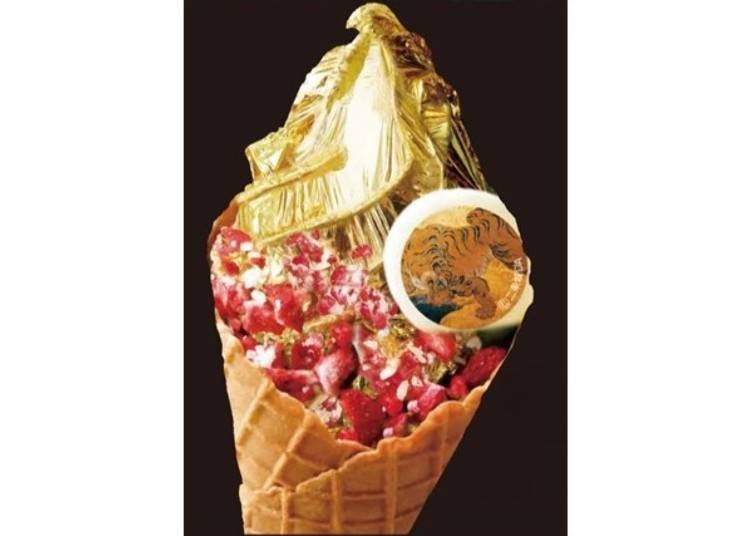
After enjoying a walk around Nijo Castle, take a break in the rest area. In the rest area's GREEN CAFE STYLE Sanoah, you can enjoy sweets made with Kyoto-sourced tea. The most popular item is the Golden Soft-serve, the color of which is fashioned after the gold leaf that decorates the furniture in Nijo Castle.

Its matcha-flavored soft serve ice cream has a thin layer of gold leaf, said to be sourced from the same gold powder used in the construction of Nijo Castle. The green tea ice cream is only just sweet enough and will hit the spot if you're tired from walking.
Another item of note is the Matcha Beer, a beverage with a beautiful, eye-catching matcha-green color. The beer's light bitterness matches wonderfully with matcha's refreshing taste.
There's also the Kyomotenashi (prices vary by toppings), which is matcha ice cream with yatsuhashi, yuba, tea dango, and other types of Kyoto toppings. The matcha langue de chat biscuits "Koto no Haoto" (700 yen or more, tax included) are similarly popular.
-
GREEN CAFE STYLE SanoahGREEN CAFE STYLE茶乃逢
- Address 541 Nijo-jo-cho, Horikawa-nishi-iru, Nijo-jo-dori, Nakagyo-ku, Kyoto 〒604-8301
- Phone Number 075-813-5055
Hours: 8:45AM to 4:45PM
Closed: Refer to Nijo Castle’s schedule
What do you need to look out for when visiting Nijo Castle Kyoto?
Being a protected cultural site, photographs and videos within the Ninomaru Palace are forbidden. You can film and photograph outside, but the use of cameras with stands is forbidden. Also, since most of the paths are made of gravel, you'll want to wear some comfortable shoes.
-

-
Address
541 Nijojocho, Horikawa Nishiiri, Nijo-dori, Nakagyo-ku, Kyoto-shi, Kyoto, 604-8301
View Map -
Nearest Station
Nijojomae Station (Tozai Line)
- Phone Number 075-841-0096
-
Address
541 Nijojocho, Horikawa Nishiiri, Nijo-dori, Nakagyo-ku, Kyoto-shi, Kyoto, 604-8301
Text by: word
Main image: (C) Nijo-jo Castle Office
*Prices and options mentioned are subject to change.
*Unless stated otherwise, all prices include tax.
Popular Tours & Activitiess
Recommended places for you
-

ISHIDAYA Hanare
Yakiniku
Kobe, Sannomiya, Kitano
-

Abeno Harukas
Landmarks
Shinsekai, Tennouji, Tsuruhashi
-

Jukuseiniku-to Namamottsuarera Nikubaru Italian Nikutaria Sannomiya
Izakaya
Kobe, Sannomiya, Kitano
-

Kanzenkoshitsuyakinikutabehodai Gyugyu Paradise Sannomiya
Yakiniku
Kobe, Sannomiya, Kitano
-

Kambei Sannomiyahonten
Yakiniku
Kobe, Sannomiya, Kitano
-
Goods

Yoshida Gennojo-Roho Kyoto Buddhist Altars
Gift Shops
Nijo Castle, Kyoto Imperial Palace
-

November Events in Kansai: Fun Festivals, Food, and Things to Do in Kyoto & Osaka
-

Celebrate a Dreamy Barbapapa Christmas at JR Osaka Station's Twilight
by: Guest Contributor
-

New Way to Reach Koyasan! Ride Nankai's 'GRAN Tenku' for a Heavenly Journey
by: Guest Contributor
-

Best Things to Do and See Around Kyoto & Osaka in September: Events and Festivals in Kansai
-
Ad

Recharge and Relax with a Healing Getaway at Kamenoi Hotel Toba
-

Curious About Sake? I Visited a Sake Brewery in Japan and Here's What I Learned
Inspiration for Accommodations
-

Spacious Family Hotel in Namba: 20 Comfortable Stays for Family Fun
-

Charming Hotels to Enjoy the Spectacular Views of Arashiyama's Autumn Leaves from Your Room
-

Experience Stunning Views of Osaka Castle from Private Spaces: Top Hotels Near Osaka Castle
-

Recommended by Visitors! Arashiyama's Best-Rated Hotels
-

Family-Friendly Universal Studios Japan Hotel with Excellent Access
-

Enjoy a Comfortable Stay in Osaka! 10 Hotels with Convenient Airport Shuttle Services
-

Top 10 Recommended Hotels Near Namba Station with Great Access
-

Enjoy Night Views from Your Room! Recommended Hotels in Namba Area
-

Top 5 Shinto Shrines and Power spots in Kansai for Love and Marriage
-

5 Unique Shrines and Temples in Osaka and Kobe for Your First Visit
by: WESTPLAN
-

6 Surprisingly Cheap Things in Japan
-

8 Most Popular Shrines in Kyoto
-

5 Must-Visit Nara Temples and Shrines: Discover the Timeless Beauty of Japan's Ancient Capital
by: WESTPLAN
-

5 Best Hotels Near Universal Studios Japan (Osaka): Top-Rated Places to Stay
by: WESTPLAN
- #best gourmet Osaka
- #things to do Osaka
- #what to do in kyoto
- #what to bring to japan
- #best gourmet Kyoto
- #new years in Osaka
- #what to buy in nanba
- #Visiting Osaka
- #onsen tattoo friendly arima
- #daiso
- #Visiting Kyoto
- #best japanese soft drinks
- #japanese fashion culture
- #japanese convenience store snacks
- #japanese nail trends













